LIVING AND WORKING WITH TECHNOLOGY: AI in Business Analysis
VerifiedAdded on 2022/10/18
|10
|2340
|8
Presentation
AI Summary
This presentation examines the profound influence of artificial intelligence (AI) on modern business practices. It begins by outlining the crucial role of business intelligence in enhancing decision-making processes, drawing from a case study and Chapter 9, emphasizing how tools like the Isaak system convert organizational data into actionable insights. The presentation then delves into AI's capabilities in boosting sales, deepening customer knowledge, and improving customer experience and productivity, while also addressing the importance of data accuracy and compliance. A significant portion of the presentation is dedicated to exploring the privacy issues associated with AI, including data exploitation, identification and tracking, and prediction capabilities. Finally, it assesses AI's impact on the workforce and employee well-being, acknowledging both job displacement concerns and potential for skill enhancement and improved workplace conditions. The presentation concludes by highlighting AI's contribution to occupational health systems and real-time employee feedback, supporting a comprehensive understanding of AI's multifaceted effects on the business landscape.
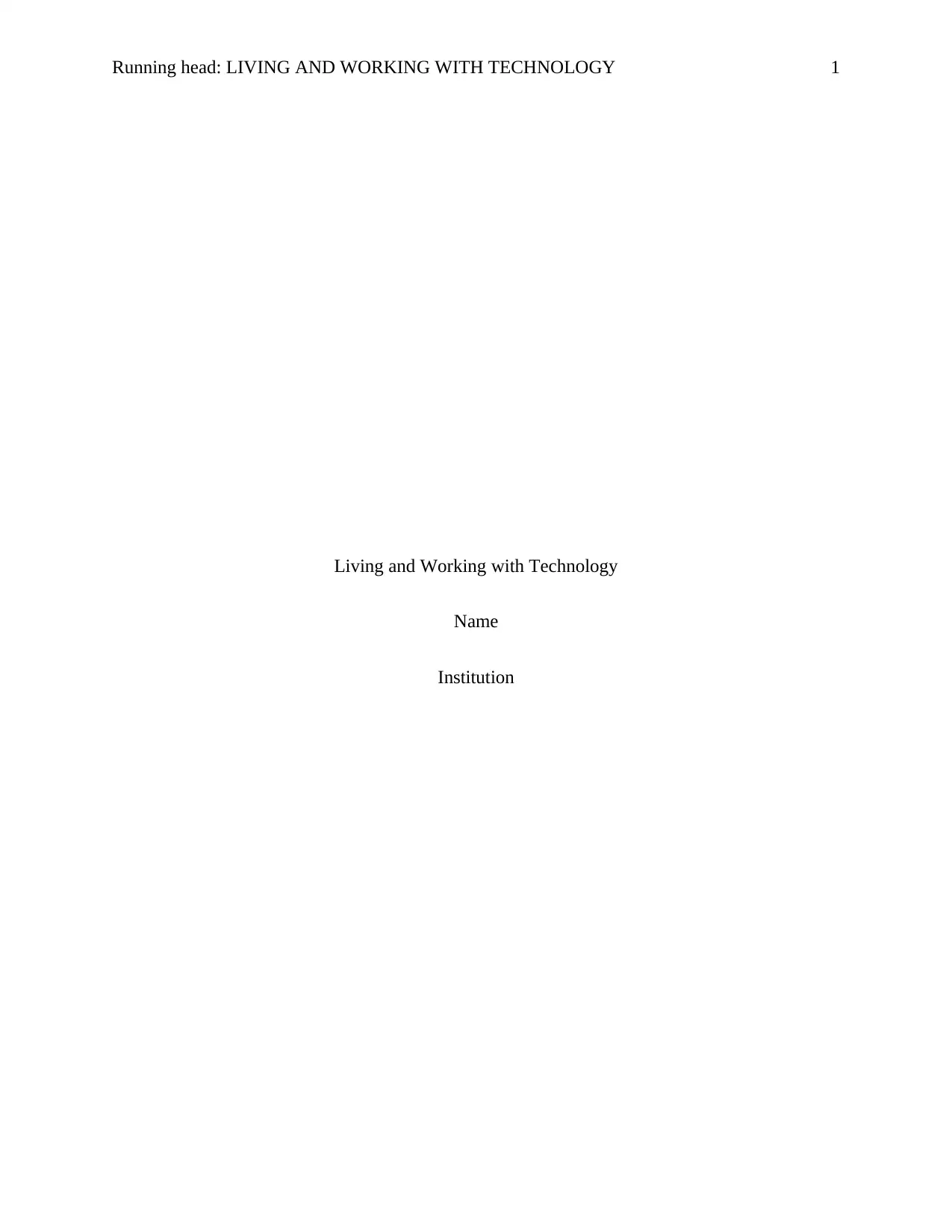
Running head: LIVING AND WORKING WITH TECHNOLOGY 1
Living and Working with Technology
Name
Institution
Living and Working with Technology
Name
Institution
Paraphrase This Document
Need a fresh take? Get an instant paraphrase of this document with our AI Paraphraser

LIVING AND WORKING WITH TECHNOLOGY 2
Introduction (slide 2)
This presentation focuses on the impact of artificial intelligence in business by
considering the content of the case study and Chapter 9. The presentation also addresses key
privacy issues involved with the use of artificial intelligence in business as well as its impact in
wellbeing and work conditions.
Making Better Decision (slide 3)
There are several steps that need to be followed when addressing a problem. Common
steps involved include problem identification, developing alternatives, selecting best alternative,
implementing and monitoring. The first process is problem identification which requires some
form of intelligence to be able to evaluate the issue with precision. In most cases, this phase
involves collecting information through machine learning among other forms of collecting data
(Hammond, Keeney & Raiffa, 2015). The following step involves developing alternatives after
identifying the solution. This phase is critical as it formulates the strategies that can be used.
Thirdly, selecting best alternative require choice on the best method before the implementation
which is the fourth stage. Lastly, it is significant for the business to evaluate whether the new
framework worked or requires improvement which will then begin from problem identification
in order to make new decisions.
Question 1. Overview (slide 4)
To begin with, from the perspective of problem solving discussed in Chapter 9 and the
content of the case study, it is evident that business intelligence plays a crucial role in improving
the performance of businesses. For instance, business intelligence is significant in making smart
decisions (Yeoh & Popovič, 2016). This implies that as business managers are required to have a
Introduction (slide 2)
This presentation focuses on the impact of artificial intelligence in business by
considering the content of the case study and Chapter 9. The presentation also addresses key
privacy issues involved with the use of artificial intelligence in business as well as its impact in
wellbeing and work conditions.
Making Better Decision (slide 3)
There are several steps that need to be followed when addressing a problem. Common
steps involved include problem identification, developing alternatives, selecting best alternative,
implementing and monitoring. The first process is problem identification which requires some
form of intelligence to be able to evaluate the issue with precision. In most cases, this phase
involves collecting information through machine learning among other forms of collecting data
(Hammond, Keeney & Raiffa, 2015). The following step involves developing alternatives after
identifying the solution. This phase is critical as it formulates the strategies that can be used.
Thirdly, selecting best alternative require choice on the best method before the implementation
which is the fourth stage. Lastly, it is significant for the business to evaluate whether the new
framework worked or requires improvement which will then begin from problem identification
in order to make new decisions.
Question 1. Overview (slide 4)
To begin with, from the perspective of problem solving discussed in Chapter 9 and the
content of the case study, it is evident that business intelligence plays a crucial role in improving
the performance of businesses. For instance, business intelligence is significant in making smart
decisions (Yeoh & Popovič, 2016). This implies that as business managers are required to have a
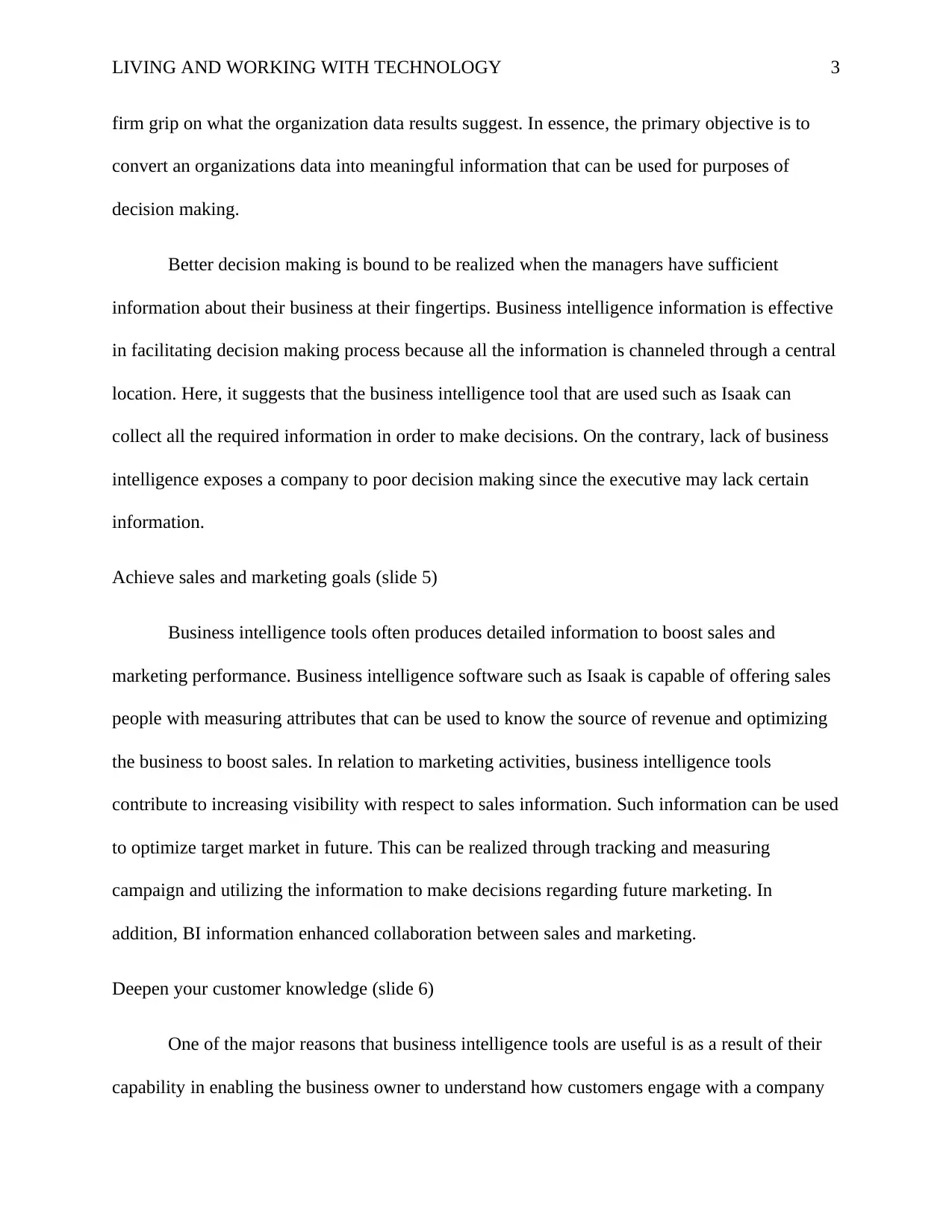
LIVING AND WORKING WITH TECHNOLOGY 3
firm grip on what the organization data results suggest. In essence, the primary objective is to
convert an organizations data into meaningful information that can be used for purposes of
decision making.
Better decision making is bound to be realized when the managers have sufficient
information about their business at their fingertips. Business intelligence information is effective
in facilitating decision making process because all the information is channeled through a central
location. Here, it suggests that the business intelligence tool that are used such as Isaak can
collect all the required information in order to make decisions. On the contrary, lack of business
intelligence exposes a company to poor decision making since the executive may lack certain
information.
Achieve sales and marketing goals (slide 5)
Business intelligence tools often produces detailed information to boost sales and
marketing performance. Business intelligence software such as Isaak is capable of offering sales
people with measuring attributes that can be used to know the source of revenue and optimizing
the business to boost sales. In relation to marketing activities, business intelligence tools
contribute to increasing visibility with respect to sales information. Such information can be used
to optimize target market in future. This can be realized through tracking and measuring
campaign and utilizing the information to make decisions regarding future marketing. In
addition, BI information enhanced collaboration between sales and marketing.
Deepen your customer knowledge (slide 6)
One of the major reasons that business intelligence tools are useful is as a result of their
capability in enabling the business owner to understand how customers engage with a company
firm grip on what the organization data results suggest. In essence, the primary objective is to
convert an organizations data into meaningful information that can be used for purposes of
decision making.
Better decision making is bound to be realized when the managers have sufficient
information about their business at their fingertips. Business intelligence information is effective
in facilitating decision making process because all the information is channeled through a central
location. Here, it suggests that the business intelligence tool that are used such as Isaak can
collect all the required information in order to make decisions. On the contrary, lack of business
intelligence exposes a company to poor decision making since the executive may lack certain
information.
Achieve sales and marketing goals (slide 5)
Business intelligence tools often produces detailed information to boost sales and
marketing performance. Business intelligence software such as Isaak is capable of offering sales
people with measuring attributes that can be used to know the source of revenue and optimizing
the business to boost sales. In relation to marketing activities, business intelligence tools
contribute to increasing visibility with respect to sales information. Such information can be used
to optimize target market in future. This can be realized through tracking and measuring
campaign and utilizing the information to make decisions regarding future marketing. In
addition, BI information enhanced collaboration between sales and marketing.
Deepen your customer knowledge (slide 6)
One of the major reasons that business intelligence tools are useful is as a result of their
capability in enabling the business owner to understand how customers engage with a company
⊘ This is a preview!⊘
Do you want full access?
Subscribe today to unlock all pages.

Trusted by 1+ million students worldwide
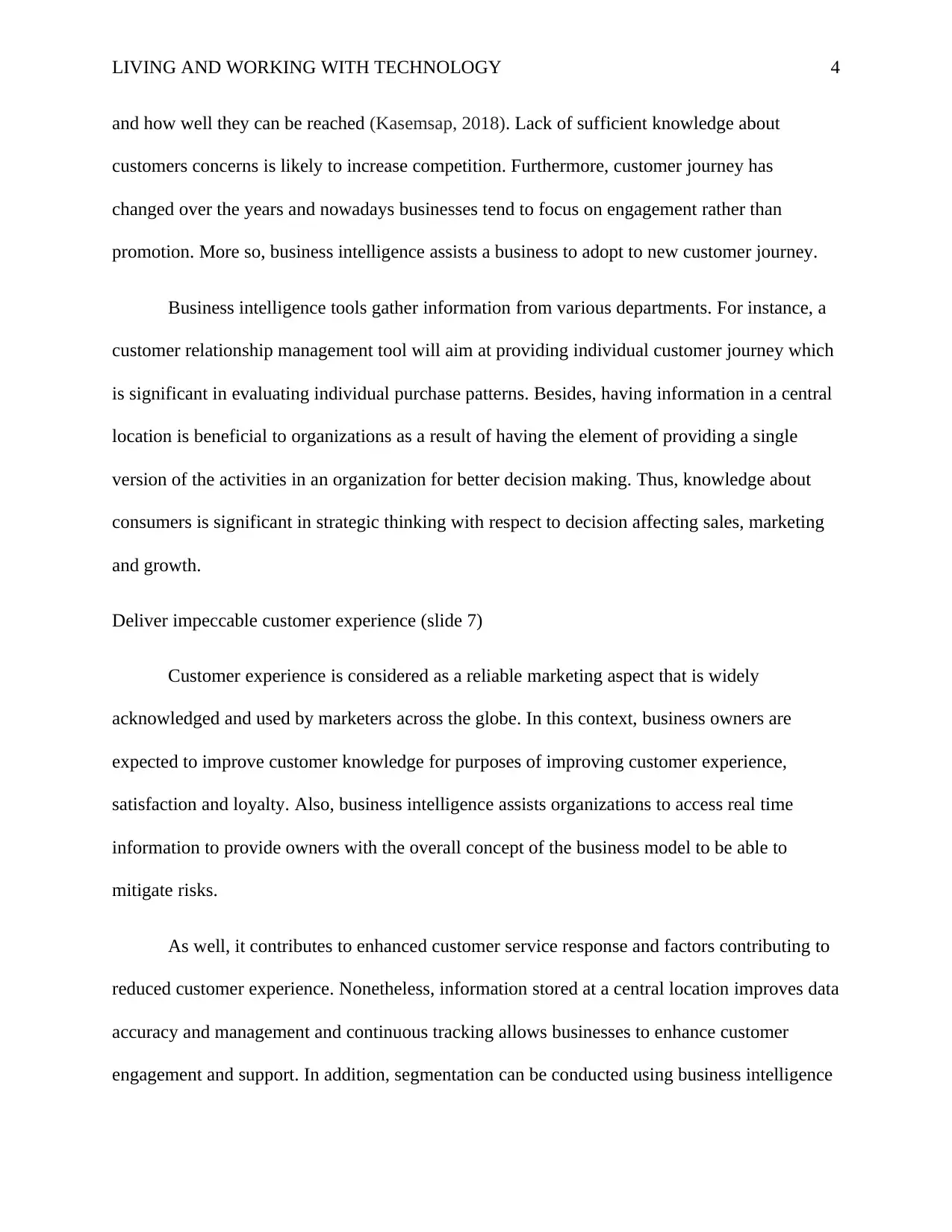
LIVING AND WORKING WITH TECHNOLOGY 4
and how well they can be reached (Kasemsap, 2018). Lack of sufficient knowledge about
customers concerns is likely to increase competition. Furthermore, customer journey has
changed over the years and nowadays businesses tend to focus on engagement rather than
promotion. More so, business intelligence assists a business to adopt to new customer journey.
Business intelligence tools gather information from various departments. For instance, a
customer relationship management tool will aim at providing individual customer journey which
is significant in evaluating individual purchase patterns. Besides, having information in a central
location is beneficial to organizations as a result of having the element of providing a single
version of the activities in an organization for better decision making. Thus, knowledge about
consumers is significant in strategic thinking with respect to decision affecting sales, marketing
and growth.
Deliver impeccable customer experience (slide 7)
Customer experience is considered as a reliable marketing aspect that is widely
acknowledged and used by marketers across the globe. In this context, business owners are
expected to improve customer knowledge for purposes of improving customer experience,
satisfaction and loyalty. Also, business intelligence assists organizations to access real time
information to provide owners with the overall concept of the business model to be able to
mitigate risks.
As well, it contributes to enhanced customer service response and factors contributing to
reduced customer experience. Nonetheless, information stored at a central location improves data
accuracy and management and continuous tracking allows businesses to enhance customer
engagement and support. In addition, segmentation can be conducted using business intelligence
and how well they can be reached (Kasemsap, 2018). Lack of sufficient knowledge about
customers concerns is likely to increase competition. Furthermore, customer journey has
changed over the years and nowadays businesses tend to focus on engagement rather than
promotion. More so, business intelligence assists a business to adopt to new customer journey.
Business intelligence tools gather information from various departments. For instance, a
customer relationship management tool will aim at providing individual customer journey which
is significant in evaluating individual purchase patterns. Besides, having information in a central
location is beneficial to organizations as a result of having the element of providing a single
version of the activities in an organization for better decision making. Thus, knowledge about
consumers is significant in strategic thinking with respect to decision affecting sales, marketing
and growth.
Deliver impeccable customer experience (slide 7)
Customer experience is considered as a reliable marketing aspect that is widely
acknowledged and used by marketers across the globe. In this context, business owners are
expected to improve customer knowledge for purposes of improving customer experience,
satisfaction and loyalty. Also, business intelligence assists organizations to access real time
information to provide owners with the overall concept of the business model to be able to
mitigate risks.
As well, it contributes to enhanced customer service response and factors contributing to
reduced customer experience. Nonetheless, information stored at a central location improves data
accuracy and management and continuous tracking allows businesses to enhance customer
engagement and support. In addition, segmentation can be conducted using business intelligence
Paraphrase This Document
Need a fresh take? Get an instant paraphrase of this document with our AI Paraphraser
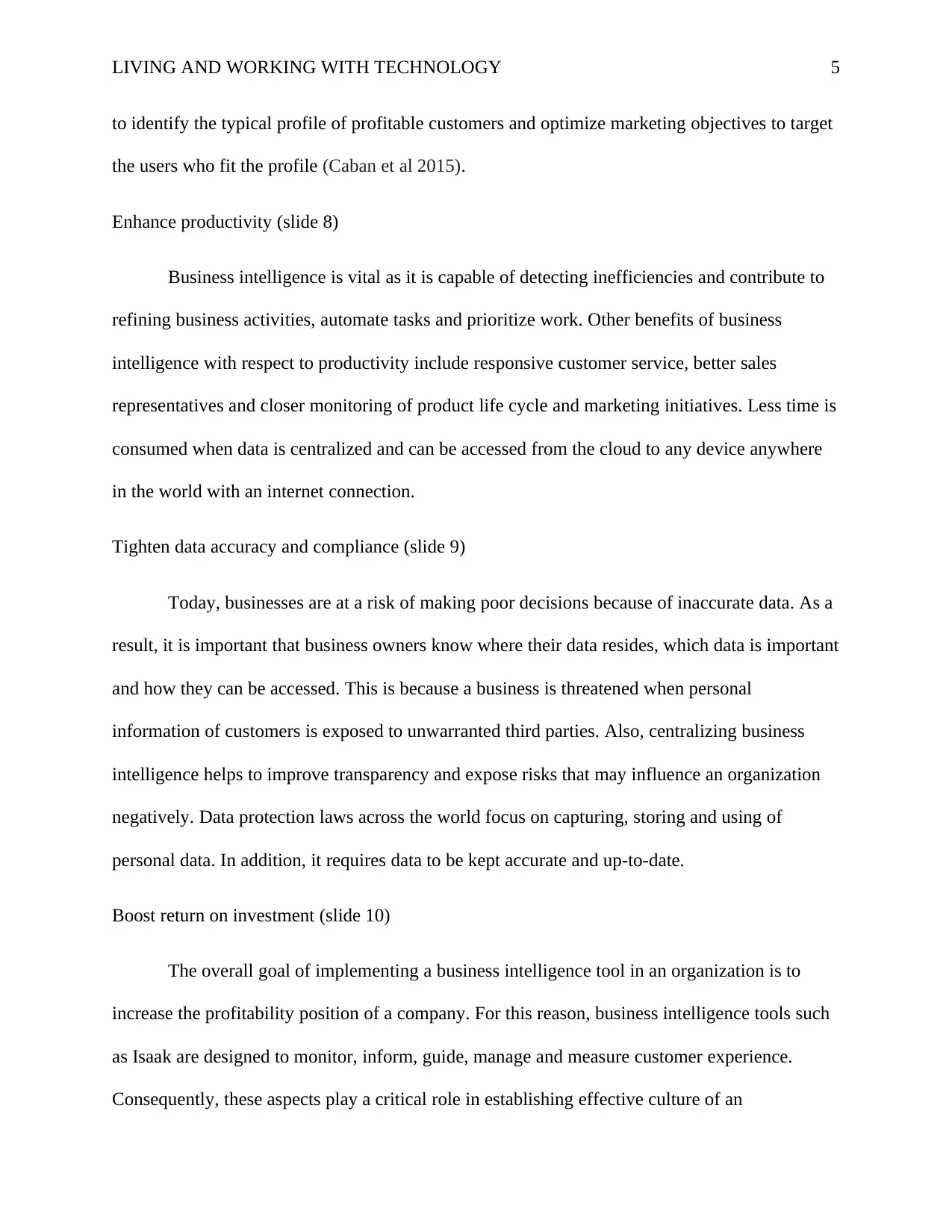
LIVING AND WORKING WITH TECHNOLOGY 5
to identify the typical profile of profitable customers and optimize marketing objectives to target
the users who fit the profile (Caban et al 2015).
Enhance productivity (slide 8)
Business intelligence is vital as it is capable of detecting inefficiencies and contribute to
refining business activities, automate tasks and prioritize work. Other benefits of business
intelligence with respect to productivity include responsive customer service, better sales
representatives and closer monitoring of product life cycle and marketing initiatives. Less time is
consumed when data is centralized and can be accessed from the cloud to any device anywhere
in the world with an internet connection.
Tighten data accuracy and compliance (slide 9)
Today, businesses are at a risk of making poor decisions because of inaccurate data. As a
result, it is important that business owners know where their data resides, which data is important
and how they can be accessed. This is because a business is threatened when personal
information of customers is exposed to unwarranted third parties. Also, centralizing business
intelligence helps to improve transparency and expose risks that may influence an organization
negatively. Data protection laws across the world focus on capturing, storing and using of
personal data. In addition, it requires data to be kept accurate and up-to-date.
Boost return on investment (slide 10)
The overall goal of implementing a business intelligence tool in an organization is to
increase the profitability position of a company. For this reason, business intelligence tools such
as Isaak are designed to monitor, inform, guide, manage and measure customer experience.
Consequently, these aspects play a critical role in establishing effective culture of an
to identify the typical profile of profitable customers and optimize marketing objectives to target
the users who fit the profile (Caban et al 2015).
Enhance productivity (slide 8)
Business intelligence is vital as it is capable of detecting inefficiencies and contribute to
refining business activities, automate tasks and prioritize work. Other benefits of business
intelligence with respect to productivity include responsive customer service, better sales
representatives and closer monitoring of product life cycle and marketing initiatives. Less time is
consumed when data is centralized and can be accessed from the cloud to any device anywhere
in the world with an internet connection.
Tighten data accuracy and compliance (slide 9)
Today, businesses are at a risk of making poor decisions because of inaccurate data. As a
result, it is important that business owners know where their data resides, which data is important
and how they can be accessed. This is because a business is threatened when personal
information of customers is exposed to unwarranted third parties. Also, centralizing business
intelligence helps to improve transparency and expose risks that may influence an organization
negatively. Data protection laws across the world focus on capturing, storing and using of
personal data. In addition, it requires data to be kept accurate and up-to-date.
Boost return on investment (slide 10)
The overall goal of implementing a business intelligence tool in an organization is to
increase the profitability position of a company. For this reason, business intelligence tools such
as Isaak are designed to monitor, inform, guide, manage and measure customer experience.
Consequently, these aspects play a critical role in establishing effective culture of an
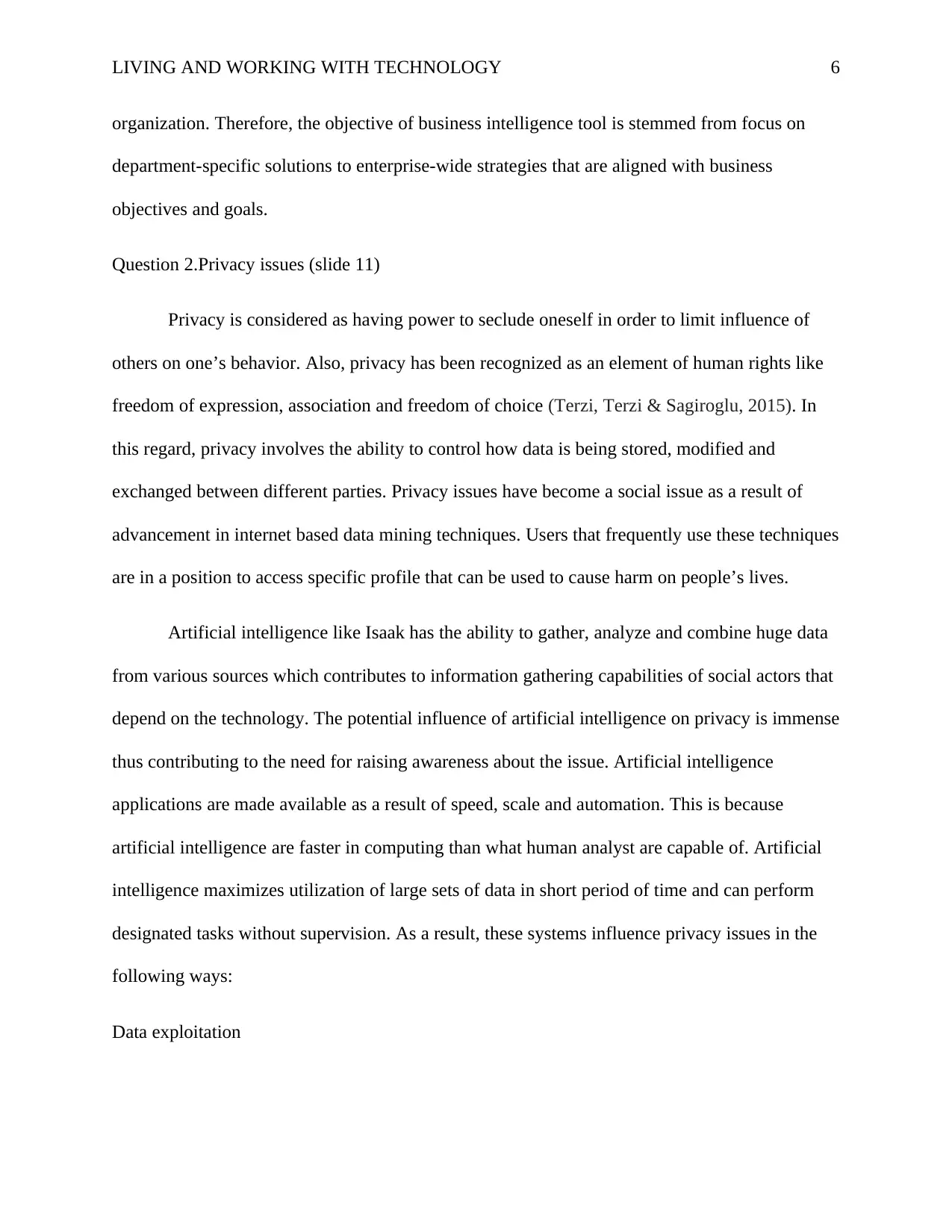
LIVING AND WORKING WITH TECHNOLOGY 6
organization. Therefore, the objective of business intelligence tool is stemmed from focus on
department-specific solutions to enterprise-wide strategies that are aligned with business
objectives and goals.
Question 2.Privacy issues (slide 11)
Privacy is considered as having power to seclude oneself in order to limit influence of
others on one’s behavior. Also, privacy has been recognized as an element of human rights like
freedom of expression, association and freedom of choice (Terzi, Terzi & Sagiroglu, 2015). In
this regard, privacy involves the ability to control how data is being stored, modified and
exchanged between different parties. Privacy issues have become a social issue as a result of
advancement in internet based data mining techniques. Users that frequently use these techniques
are in a position to access specific profile that can be used to cause harm on people’s lives.
Artificial intelligence like Isaak has the ability to gather, analyze and combine huge data
from various sources which contributes to information gathering capabilities of social actors that
depend on the technology. The potential influence of artificial intelligence on privacy is immense
thus contributing to the need for raising awareness about the issue. Artificial intelligence
applications are made available as a result of speed, scale and automation. This is because
artificial intelligence are faster in computing than what human analyst are capable of. Artificial
intelligence maximizes utilization of large sets of data in short period of time and can perform
designated tasks without supervision. As a result, these systems influence privacy issues in the
following ways:
Data exploitation
organization. Therefore, the objective of business intelligence tool is stemmed from focus on
department-specific solutions to enterprise-wide strategies that are aligned with business
objectives and goals.
Question 2.Privacy issues (slide 11)
Privacy is considered as having power to seclude oneself in order to limit influence of
others on one’s behavior. Also, privacy has been recognized as an element of human rights like
freedom of expression, association and freedom of choice (Terzi, Terzi & Sagiroglu, 2015). In
this regard, privacy involves the ability to control how data is being stored, modified and
exchanged between different parties. Privacy issues have become a social issue as a result of
advancement in internet based data mining techniques. Users that frequently use these techniques
are in a position to access specific profile that can be used to cause harm on people’s lives.
Artificial intelligence like Isaak has the ability to gather, analyze and combine huge data
from various sources which contributes to information gathering capabilities of social actors that
depend on the technology. The potential influence of artificial intelligence on privacy is immense
thus contributing to the need for raising awareness about the issue. Artificial intelligence
applications are made available as a result of speed, scale and automation. This is because
artificial intelligence are faster in computing than what human analyst are capable of. Artificial
intelligence maximizes utilization of large sets of data in short period of time and can perform
designated tasks without supervision. As a result, these systems influence privacy issues in the
following ways:
Data exploitation
⊘ This is a preview!⊘
Do you want full access?
Subscribe today to unlock all pages.

Trusted by 1+ million students worldwide
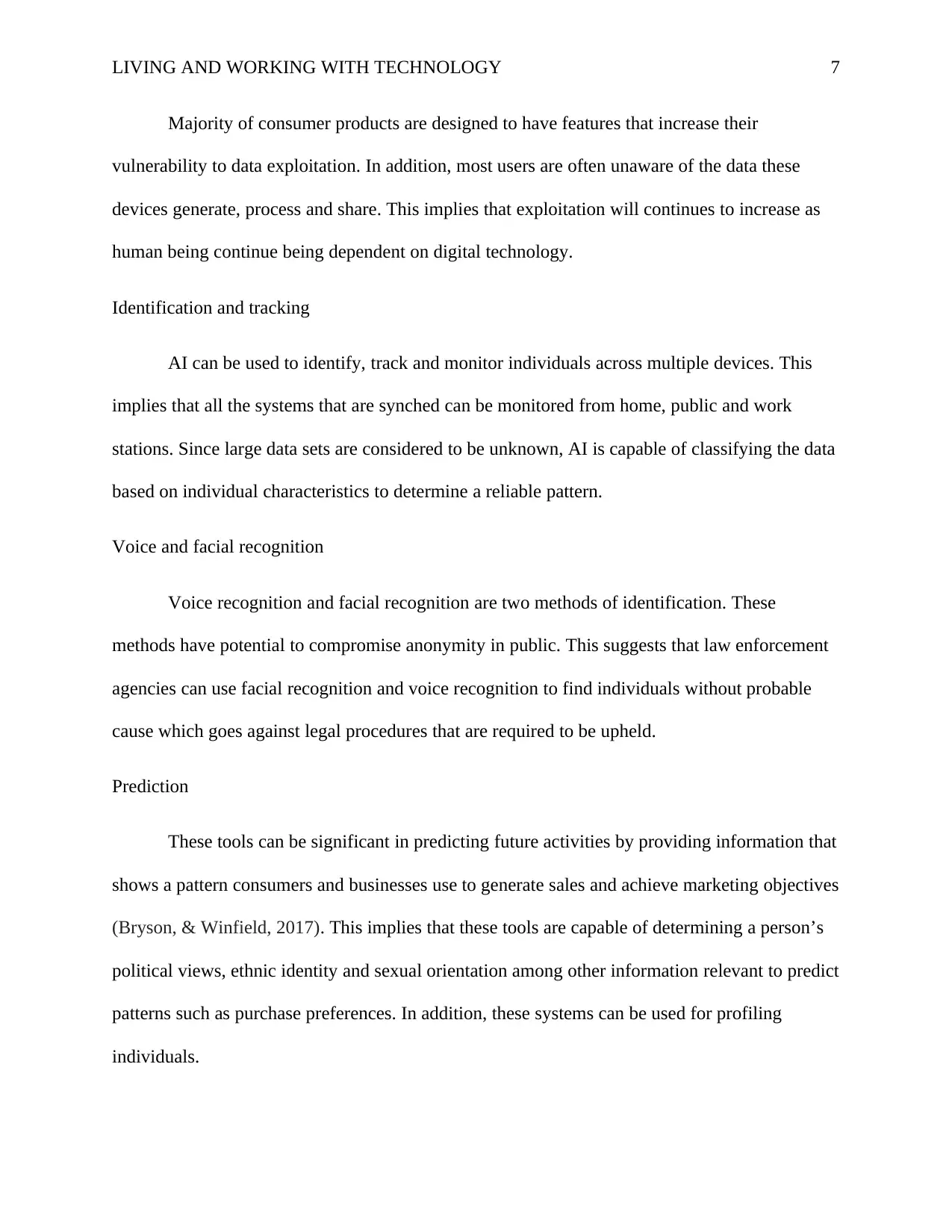
LIVING AND WORKING WITH TECHNOLOGY 7
Majority of consumer products are designed to have features that increase their
vulnerability to data exploitation. In addition, most users are often unaware of the data these
devices generate, process and share. This implies that exploitation will continues to increase as
human being continue being dependent on digital technology.
Identification and tracking
AI can be used to identify, track and monitor individuals across multiple devices. This
implies that all the systems that are synched can be monitored from home, public and work
stations. Since large data sets are considered to be unknown, AI is capable of classifying the data
based on individual characteristics to determine a reliable pattern.
Voice and facial recognition
Voice recognition and facial recognition are two methods of identification. These
methods have potential to compromise anonymity in public. This suggests that law enforcement
agencies can use facial recognition and voice recognition to find individuals without probable
cause which goes against legal procedures that are required to be upheld.
Prediction
These tools can be significant in predicting future activities by providing information that
shows a pattern consumers and businesses use to generate sales and achieve marketing objectives
(Bryson, & Winfield, 2017). This implies that these tools are capable of determining a person’s
political views, ethnic identity and sexual orientation among other information relevant to predict
patterns such as purchase preferences. In addition, these systems can be used for profiling
individuals.
Majority of consumer products are designed to have features that increase their
vulnerability to data exploitation. In addition, most users are often unaware of the data these
devices generate, process and share. This implies that exploitation will continues to increase as
human being continue being dependent on digital technology.
Identification and tracking
AI can be used to identify, track and monitor individuals across multiple devices. This
implies that all the systems that are synched can be monitored from home, public and work
stations. Since large data sets are considered to be unknown, AI is capable of classifying the data
based on individual characteristics to determine a reliable pattern.
Voice and facial recognition
Voice recognition and facial recognition are two methods of identification. These
methods have potential to compromise anonymity in public. This suggests that law enforcement
agencies can use facial recognition and voice recognition to find individuals without probable
cause which goes against legal procedures that are required to be upheld.
Prediction
These tools can be significant in predicting future activities by providing information that
shows a pattern consumers and businesses use to generate sales and achieve marketing objectives
(Bryson, & Winfield, 2017). This implies that these tools are capable of determining a person’s
political views, ethnic identity and sexual orientation among other information relevant to predict
patterns such as purchase preferences. In addition, these systems can be used for profiling
individuals.
Paraphrase This Document
Need a fresh take? Get an instant paraphrase of this document with our AI Paraphraser
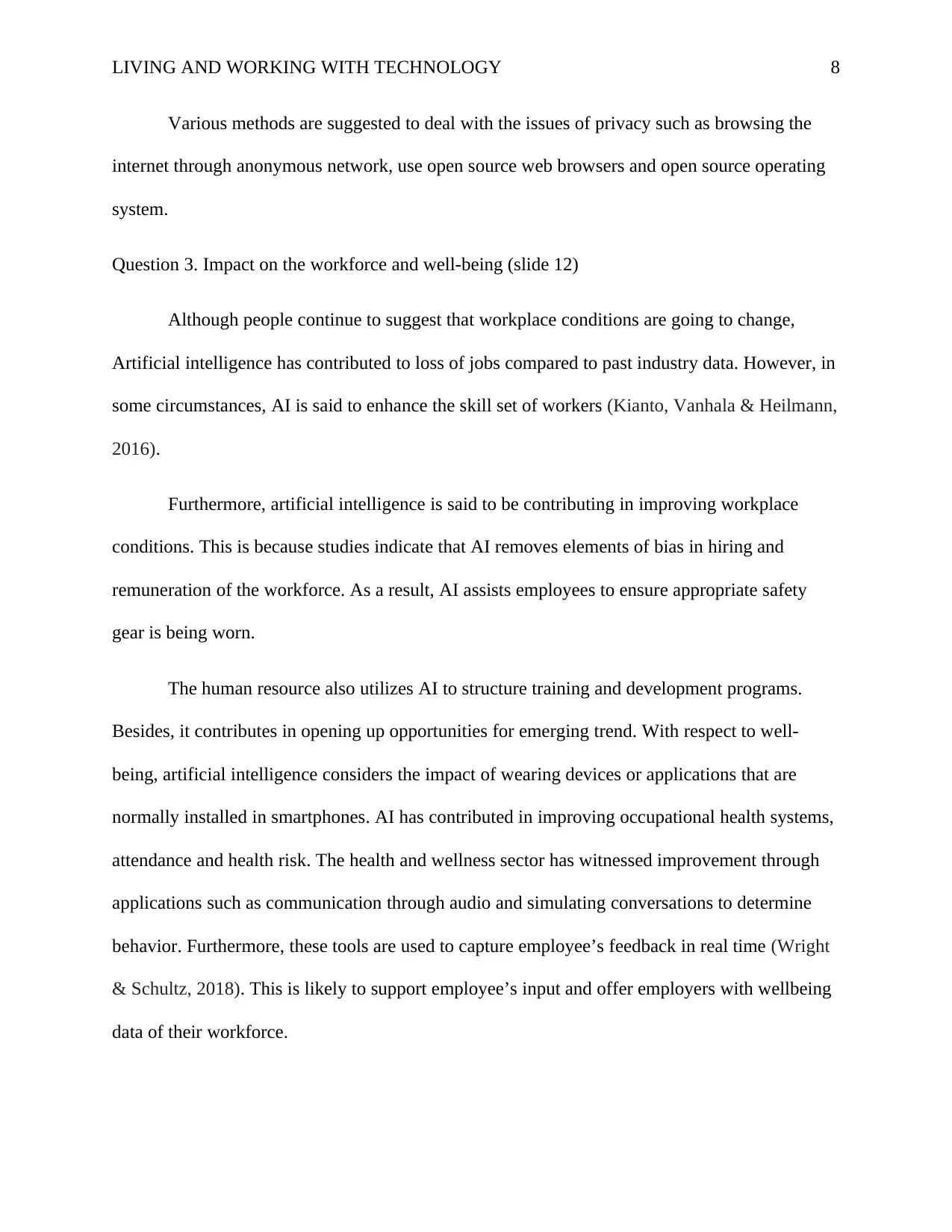
LIVING AND WORKING WITH TECHNOLOGY 8
Various methods are suggested to deal with the issues of privacy such as browsing the
internet through anonymous network, use open source web browsers and open source operating
system.
Question 3. Impact on the workforce and well-being (slide 12)
Although people continue to suggest that workplace conditions are going to change,
Artificial intelligence has contributed to loss of jobs compared to past industry data. However, in
some circumstances, AI is said to enhance the skill set of workers (Kianto, Vanhala & Heilmann,
2016).
Furthermore, artificial intelligence is said to be contributing in improving workplace
conditions. This is because studies indicate that AI removes elements of bias in hiring and
remuneration of the workforce. As a result, AI assists employees to ensure appropriate safety
gear is being worn.
The human resource also utilizes AI to structure training and development programs.
Besides, it contributes in opening up opportunities for emerging trend. With respect to well-
being, artificial intelligence considers the impact of wearing devices or applications that are
normally installed in smartphones. AI has contributed in improving occupational health systems,
attendance and health risk. The health and wellness sector has witnessed improvement through
applications such as communication through audio and simulating conversations to determine
behavior. Furthermore, these tools are used to capture employee’s feedback in real time (Wright
& Schultz, 2018). This is likely to support employee’s input and offer employers with wellbeing
data of their workforce.
Various methods are suggested to deal with the issues of privacy such as browsing the
internet through anonymous network, use open source web browsers and open source operating
system.
Question 3. Impact on the workforce and well-being (slide 12)
Although people continue to suggest that workplace conditions are going to change,
Artificial intelligence has contributed to loss of jobs compared to past industry data. However, in
some circumstances, AI is said to enhance the skill set of workers (Kianto, Vanhala & Heilmann,
2016).
Furthermore, artificial intelligence is said to be contributing in improving workplace
conditions. This is because studies indicate that AI removes elements of bias in hiring and
remuneration of the workforce. As a result, AI assists employees to ensure appropriate safety
gear is being worn.
The human resource also utilizes AI to structure training and development programs.
Besides, it contributes in opening up opportunities for emerging trend. With respect to well-
being, artificial intelligence considers the impact of wearing devices or applications that are
normally installed in smartphones. AI has contributed in improving occupational health systems,
attendance and health risk. The health and wellness sector has witnessed improvement through
applications such as communication through audio and simulating conversations to determine
behavior. Furthermore, these tools are used to capture employee’s feedback in real time (Wright
& Schultz, 2018). This is likely to support employee’s input and offer employers with wellbeing
data of their workforce.
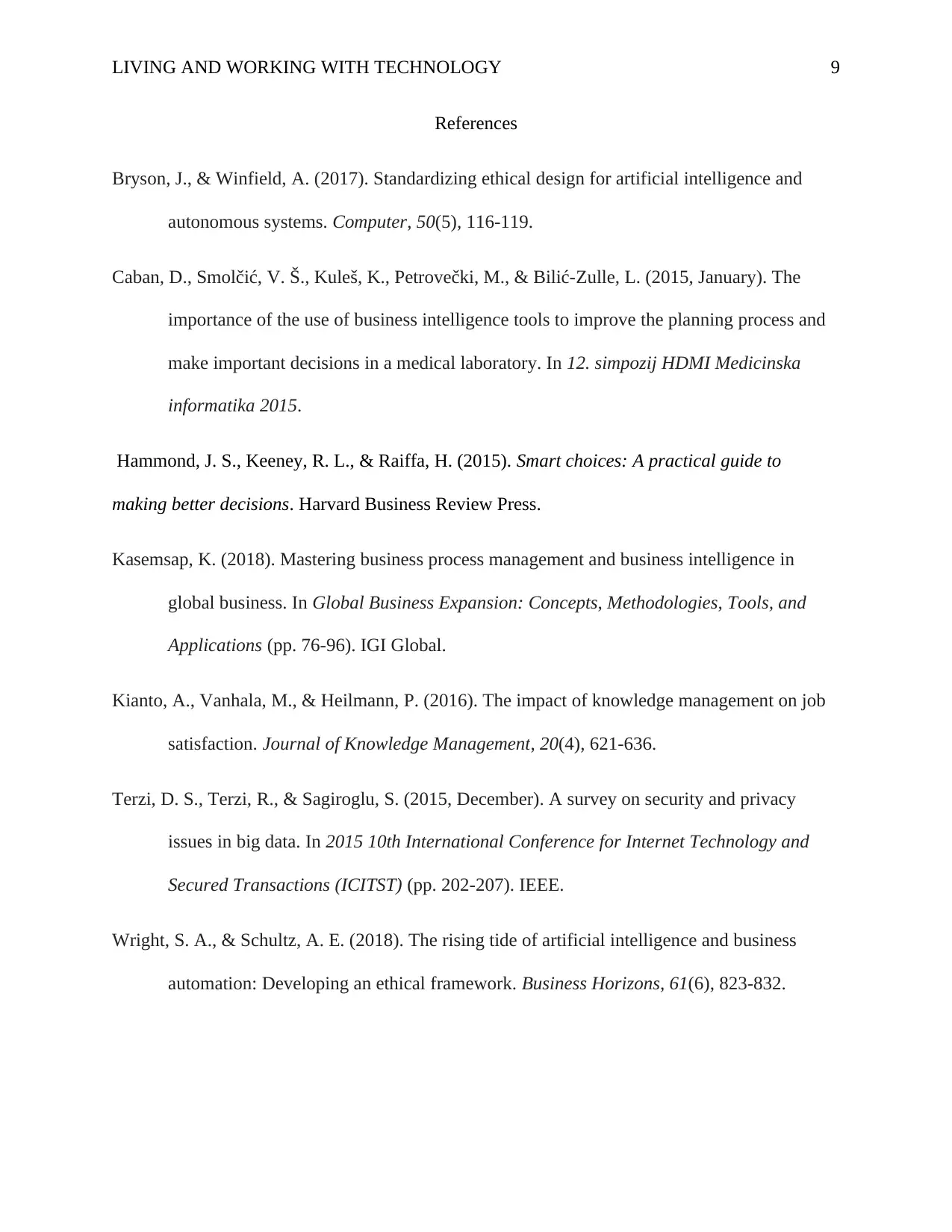
LIVING AND WORKING WITH TECHNOLOGY 9
References
Bryson, J., & Winfield, A. (2017). Standardizing ethical design for artificial intelligence and
autonomous systems. Computer, 50(5), 116-119.
Caban, D., Smolčić, V. Š., Kuleš, K., Petrovečki, M., & Bilić-Zulle, L. (2015, January). The
importance of the use of business intelligence tools to improve the planning process and
make important decisions in a medical laboratory. In 12. simpozij HDMI Medicinska
informatika 2015.
Hammond, J. S., Keeney, R. L., & Raiffa, H. (2015). Smart choices: A practical guide to
making better decisions. Harvard Business Review Press.
Kasemsap, K. (2018). Mastering business process management and business intelligence in
global business. In Global Business Expansion: Concepts, Methodologies, Tools, and
Applications (pp. 76-96). IGI Global.
Kianto, A., Vanhala, M., & Heilmann, P. (2016). The impact of knowledge management on job
satisfaction. Journal of Knowledge Management, 20(4), 621-636.
Terzi, D. S., Terzi, R., & Sagiroglu, S. (2015, December). A survey on security and privacy
issues in big data. In 2015 10th International Conference for Internet Technology and
Secured Transactions (ICITST) (pp. 202-207). IEEE.
Wright, S. A., & Schultz, A. E. (2018). The rising tide of artificial intelligence and business
automation: Developing an ethical framework. Business Horizons, 61(6), 823-832.
References
Bryson, J., & Winfield, A. (2017). Standardizing ethical design for artificial intelligence and
autonomous systems. Computer, 50(5), 116-119.
Caban, D., Smolčić, V. Š., Kuleš, K., Petrovečki, M., & Bilić-Zulle, L. (2015, January). The
importance of the use of business intelligence tools to improve the planning process and
make important decisions in a medical laboratory. In 12. simpozij HDMI Medicinska
informatika 2015.
Hammond, J. S., Keeney, R. L., & Raiffa, H. (2015). Smart choices: A practical guide to
making better decisions. Harvard Business Review Press.
Kasemsap, K. (2018). Mastering business process management and business intelligence in
global business. In Global Business Expansion: Concepts, Methodologies, Tools, and
Applications (pp. 76-96). IGI Global.
Kianto, A., Vanhala, M., & Heilmann, P. (2016). The impact of knowledge management on job
satisfaction. Journal of Knowledge Management, 20(4), 621-636.
Terzi, D. S., Terzi, R., & Sagiroglu, S. (2015, December). A survey on security and privacy
issues in big data. In 2015 10th International Conference for Internet Technology and
Secured Transactions (ICITST) (pp. 202-207). IEEE.
Wright, S. A., & Schultz, A. E. (2018). The rising tide of artificial intelligence and business
automation: Developing an ethical framework. Business Horizons, 61(6), 823-832.
⊘ This is a preview!⊘
Do you want full access?
Subscribe today to unlock all pages.

Trusted by 1+ million students worldwide
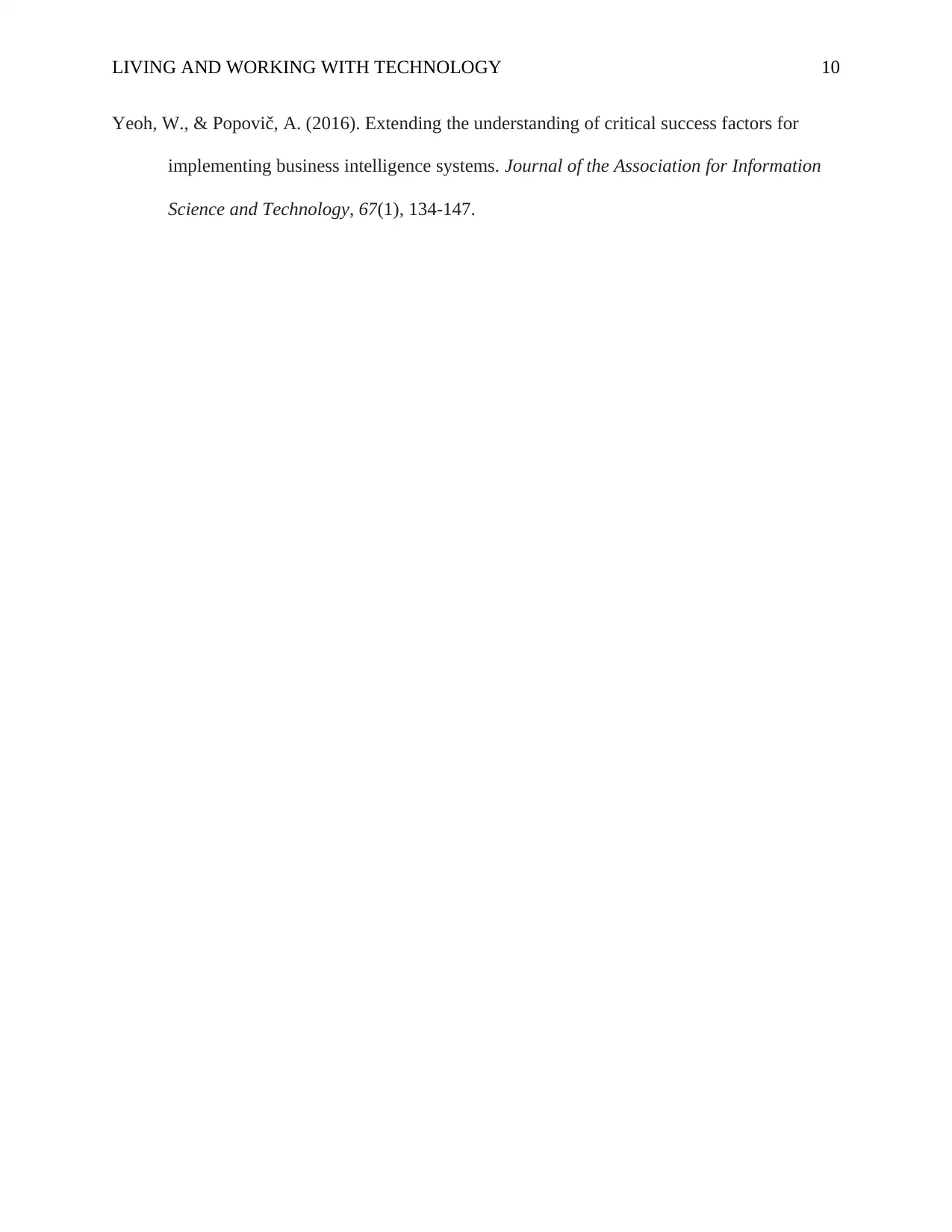
LIVING AND WORKING WITH TECHNOLOGY 10
Yeoh, W., & Popovič, A. (2016). Extending the understanding of critical success factors for
implementing business intelligence systems. Journal of the Association for Information
Science and Technology, 67(1), 134-147.
Yeoh, W., & Popovič, A. (2016). Extending the understanding of critical success factors for
implementing business intelligence systems. Journal of the Association for Information
Science and Technology, 67(1), 134-147.
1 out of 10
Related Documents
Your All-in-One AI-Powered Toolkit for Academic Success.
+13062052269
info@desklib.com
Available 24*7 on WhatsApp / Email
![[object Object]](/_next/static/media/star-bottom.7253800d.svg)
Unlock your academic potential
Copyright © 2020–2025 A2Z Services. All Rights Reserved. Developed and managed by ZUCOL.





